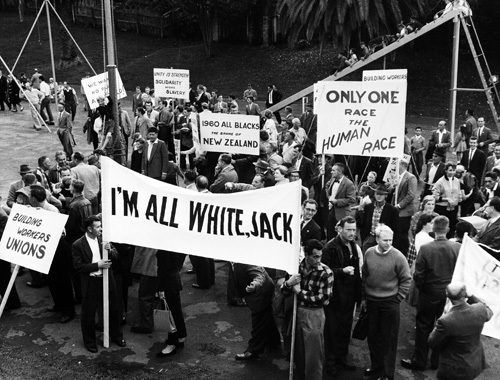CURATOR Ron Brownson ORGANISER Auckland Art Gallery OTHER VENUES Auckland Art Gallery, – PUBLICATION publisher Random House and Auckland Art Gallery, essays Ron Brownson, Marti Friedlander
Photographer Marti Friedlander documented post-war New Zealand. Her retrospective includes 150 black-and-white photos organised around seven themes: New Zealand, the Pacific, and Israel; protest and wine; kuia moko kauwae and artists.
Born in London in 1928, Friedlander grows up in a Jewish Orphan Home. She is awarded a scholarship to Camberwell School of Art and is then employed as a photography assistant in the renowned portrait and fashion studio of Douglas Glass and Gordon Crocker. She arrives in New Zealand in 1958, and, in 1960, takes her first important photo here, during an anti-apartheid protest in Auckland's Myers Park.
Friedlander becomes a full-time photographer in 1963. Her early assignments include work for the Listener and the Herald. In 1965, she travels through New Zealand with Dick Scott, photographing vineyards and winemakers. This year also marks the beginning of her self-motivated work, photographing artists, writers, and ceramists. Widely reproduced, her portraits become important documents of New Zealand's cultural life.
Friedlander is known for her book projects, including Moko: The Art of Maori Tattooing (1972, with Michael King), Larks in a Paradise (1974, with James McNeish), Contemporary New Zealand Painters A–M (1980, with Jim and Mary Barr), and Pioneers of New Zealand Wine (2002, with Dick Scott).
In 1999, Friedlander receives the Companion of New Zealand Order of Merit for services to photography. In 2007, the Marti Friedlander Photographic Award is launched. Supported by the Arts Foundation, it's presented every two years to a photographer of excellence. Friedlander herself receives an Arts Foundation Icon award in 2011.
'One day', Friedlander was fond of saying, 'we will all just be a photograph.' She dies in 2016. Her Guardian obituary read, 'Over a long career, her curious outsider's lens produced images through which New Zealand came to understand its Māori people and itself.'
















































































































